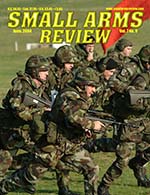Hellenic National War Museum Athens, Greece
by Prokopios A. Ziros
The Hellenic (Greek) War Museum was created in July of 1975 and it is currently being managed by the Greek Military. The collections displayed in the museum contain over 20,000 items that will take the visitor on an incredible trip through the most important moments of Greek history. At the same time, the museum operates as a research area, study and training center.
In the exhibition halls of the Hellenic War Museum, the Greek participation in World War II is presented by various objects such as a number of important paintings by well-known Greek artists of the period. Also included are weapons of the period 1938-1944, personal objects belonging to eminent officers, battle plans, models of war ships, and airplanes as well as posters and sketches and photographs. A Greek victory was not an easy matter in World War II due to the well-prepared and strongly equipped war machine of the Axis powers. However, through the forceful resistance to the fascist attack, the heroism of the Greek Army and the support it received from the Greek population, made possible a victory against the Italian Army. The Italians outnumbered the Greek Army by a 3-to-1 ratio, and were better equipped on the Albanian front. As a result of Greek resistance, the time schedule of the war operations of the Axis powers was turned back. The heroic struggle of the Greek nation is a feat that can be held as an example for future generations. Many European nations bowed to the axis, but Greece’s Prime Minister John Metaxas said “No” to the telegram that the Italian ambassador to Greece presented him with, asking Greece to unconditionally surrender. Later on in the War, English Prime Minister Churchill paid a great compliment to the Greek fighters by saying, “Greeks don’t fight like heroes, but heroes fight like Greeks.”
Another great weapons display that you will see are the weapons used through the Balkan War campaigns of 1912-1913. These weapons safeguarded the human rights of the Christians who had labored under the Turkish yoke, and they put an end to the misery of the enslaved people, which, for centuries, had endured martyrdom and abasement. The weapons you will see related to the Balkan wars are the Army rifle Gras M 1874, Mannlicher-Schoenauer M1903, Revolver Modele D’ Ordonnance 1873 and 1874, Browning M1900, Bergman-Bayard M1908 & M1910, Mannlicher pistol M1905, and several types of officers swords.
Some of the weapons you can expect to see in the museum, used in WWII and Korean War, include the following: MG34, MP40, MP41, M1928 and M1 Thompson, Grease guns, M1 and M2 .30 Carbines, Sten submachine gun, Bren LMG, Vickers, Browning M1919 belt-fed machine guns, M2HB 50 cal., 20mm, Hotchkiss, Berettas, BAR Maxim gun, Schwarzlose, Chauchat, along with several types of mortars and cannons and airplanes on the outside of the museum.
A beautiful collection of uniforms and very old firearms, swords and armor including medieval armor, are also displayed. A Greek Military High ranking Officer collected the weapons and exhibits throughout his military career and donated his collection to the Museum and it is named after him, the “Saroglos Collection.”
One should also expect to see exhibits from the Stone Age and the early Bronze and Middle and Late Bronze Ages with emphasis on the Mycenaean period. The materials displayed in these rooms include a series of original weapons and tools from the collection of the War museum. Of special interest are hand axes of Paleolithic types, Neolithic Celts, and a Bronze dagger of early Bronze Age type, a great variety of blades and other tools made of melian obsidian and a number of Mycenaean bronze tools and spearheads.
The front yard of the Museum is covered with several different types of cannons, from the Greek revolution of 1821, to the newer war of Korea. You can also expect to find several planes, new and old. There is also a great library of old and newer war and gun books.
The museum is open daily except Monday from 9:00 a.m. to 2:00 p.m. and the entrance is free. It is located at Vassilissis Sophias and Rizari 2, Athens. The location is very close to central Athens and all of the ancient ruins like the Acropolis and the Parthenon, which one must visit if in Greece, and should be visited by all gun and history enthusiasts. A must do for the family that loves history, which Greece is so famous for.
This article first appeared in Small Arms Review V7N9 (June 2004) |
| SUBSCRIBER COMMENT AREA |
Comments have not been generated for this article.









